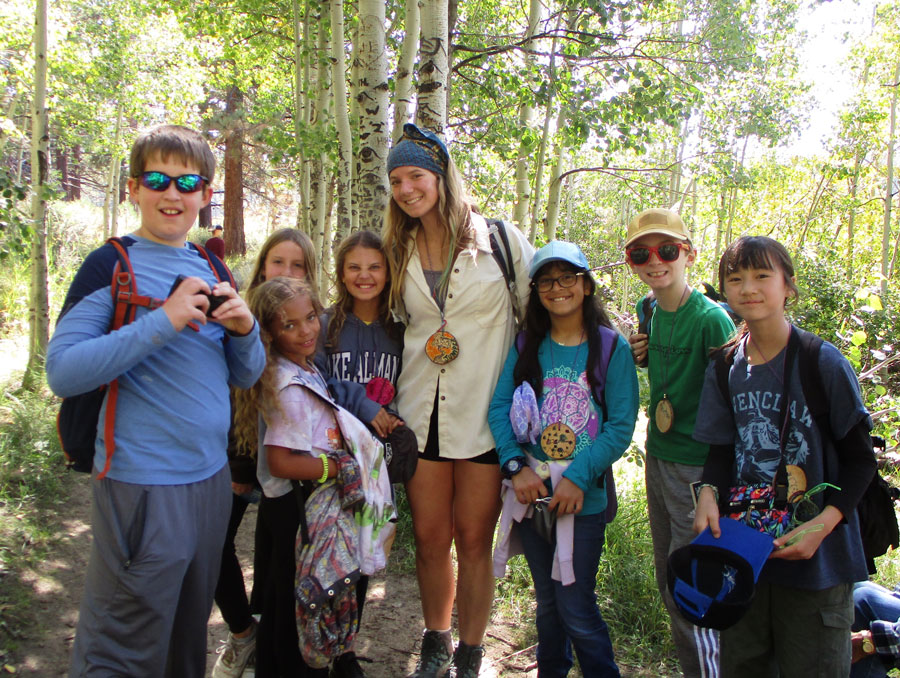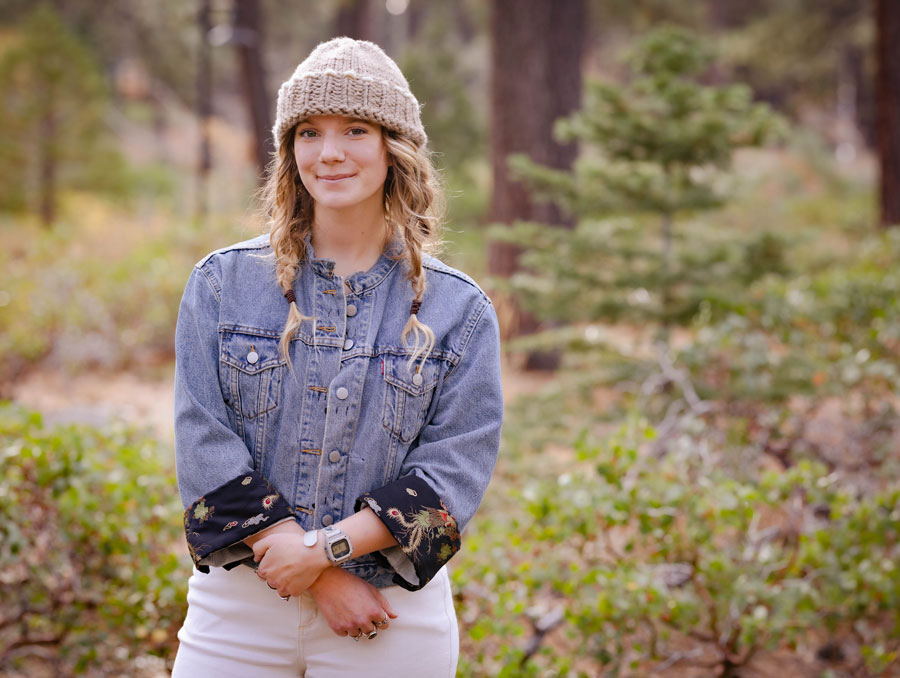Paired up middle school students – one of them blindfolded, the other leading the way – stumble through a field, around tangled manzanita and over thick underbrush to find a tree, their tree. In a forest of bristlecone, ponderosa, lodgepole and Washoe pines as well as mountain hemlock and quaking aspens, each pair of children pick out a single unique tree. The student with the blindfold on is instructed to reach out and feel around. Is the tree rough or smooth? Does it have leaves or do they feel clusters of pine needles and pinecones? Is the bark thick with deep grooves or are the ridges tucked tightly together in narrow rows? Can they get their arms all the way around the tree? What does it smell like? Once the exploration is complete, the guiding child leads their blindfolded partner back to the center of the field. The bandanas are taken off their eyes and they are asked to pick out the tree they met so intimately just moments before.
It's an exercise that cultivates an immediate connection between these enthusiastic pre-teens and the natural world while also teaching some of the basics of ecology and arboriculture. This is just one of several experiential exercises incorporated into the Great Basin Outdoor School’s curriculum and is a favorite of volunteer and University of Nevada, Reno at Lake Tahoe student Emma Montgomery. The Great Basin Outdoor School is a Reno-based nonprofit that brings elementary and middle school students to the Sierra Nevada and Lake Tahoe Basin to learn about ecology and the environment through experiential learning in the outdoors. Montgomery, who’s been volunteering with the organization for the past several months, stands about a foot taller than the kids stumbling around the field as she helps guide them in the exercise, suggesting different senses to explore or characteristics they might apply to their tree. Montgomery has been volunteering with the Great Basin Outdoor School as part of her interdisciplinary studies in sustainability and outdoor adventure leadership. Coming to Lake Tahoe from Houston, Texas, Montgomery’s exposure to the natural environment had been limited. When she began taking classes at the Wayne L. Prim Campus in Incline Village, she was exposed to activities like backpacking, skiing and rock climbing while also learning about the environment and sustainability. She experienced a perspective shift that she wanted to pass on.
"It’s so much more meaningful to learn about the land and the natural environment while you’re in it."

Emma Montgomery stands surrounded by a group of Great Basin Outdoor School students. Photo courtesy of the Great Basin Outdoor School
“When I was in high school, we didn’t learn a lot about climate change and why we need to protect the environment,” Montgomery said. “Coming here, my first semester in college I took all these sustainability classes and just thought ‘Wow, there’s so much I didn’t know.’ I think it’s really important for kids to be exposed at a young age to sustainability, to environmental stewardship and to the outdoors. People, kids included, are only going to care about something if they’ve been exposed to it. It’s hard to care if trees get cut down to build a store if you’ve never been in the area and don’t know anything about the trees.”
Montgomery started volunteering at the Great Basin Outdoor School in July of 2023 as part of her interdisciplinary service learning course supervised by University of Nevada, Reno at Lake Tahoe faculty member and senior lecturer Katie Zanto. Zanto’s teaching philosophy is grounded in interdisciplinary, experiential and project-based learning.
“The class is all about supporting deeper reflection and deeper learning about their impact in the community,” Zanto said. “The goal is to integrate the student’s skills and passions outside of school with their multiple disciplines through working with an organization.”
As a volunteer naturalist for the Great Basin Outdoor School, Montgomery led groups in activities like Meet a Tree and other educational games like Jays and Chickadees where the children mimic the behaviors of the mountain chickadees (storing food in hiding spots around the forest) and the stellar jays (stealing the hidden caches of food). She’s taken groups to different locations around the Lake Tahoe Basin like Rabe Meadows, Galena Creek and Mt. Rose Meadows to connect with the natural environment and learn about area ecology and habitats.
“It’s so much more meaningful to learn about the land and the natural environment while you’re in it,” Montgomery said.
As part of her coursework, Montgomery has conducted research into the benefits of outdoor, active education – and there are many. The Great Basin Outdoor School sites several studies highlighting the impacts of outdoor education on children’s achievement academically, socially and emotionally. Students who engage in outdoor education experience everything from increased standardized test scores to enhanced attitudes about school, improved in-school behavior, improved attendance and decreases in Attention Deficit Hyperactivity Disorder (ADHD).
Executive Director of the nonprofit and University alumna, Emily Baldwin (B.S. Wildlife Ecology and Conservation, ‘21) witnesses these impacts first-hand.
“Lots of our students are from designated Title 1 schools, so they’re low-income and minority students who have often never been to Lake Tahoe,” Baldwin said. “It’s really eye-opening for students to get that connection to nature, to learn about and enjoy the outdoors. You can see that the activities and the movement boost the students’ engagement as opposed to them being sedentary in a classroom.”
The benefits of breaking up time sitting and incorporating movement into educational experiences are well-documented. The psychological and physiological benefits of exposure to nature is a hot topic in the medical field right now. At the same time, research into the adverse health effects of sitting sedentary for long periods (even short periods) of time is overwhelming. Still, school-age children in the U.S. are given just 25 minutes of recess time on average to spend playing outdoors. Learning happens overwhelmingly indoors, in seats and in workbooks.
The Great Basin Outdoor School has known better, challenging this mindset for the past 25 years with the mission to “ignite children's passion for learning and foster cooperation, respect and responsibility through hands-on discovery in the outdoor classroom.” Montgomery knew better the moment she experienced tromping through the Sierra Nevada Mountains above Lake Tahoe. The kids knew better when they smashed their noses up against the bark of a ponderosa pine and inhaled the vanilla scent of the tree.
"For there to be a change in the world, with all that’s happening with climate change and the economy and development and our attempts to move away from fossil fuels – learning outside and experiential education can really make a difference. When people like what the outdoors gives them, they want to give back – it inspires reciprocity with nature."
Once all the students make their way back to the center of the field and the exercise is complete, Montgomery asks them if they feel like they know their surroundings more. She asks what new things they’re noticing in the environment around them. It is a calm, almost meditative process of reflection even as the kids enthusiastically share their answers. The students’ focus moves intentionally from tree to sky to grass to bird. They’re captivated and attentive. They’re learning.
As Montgomery nears graduation, she hopes to pursue a career where she can combine all her interests: sustainability, early childhood education and outdoor adventuring. Her time with the Great Basin Outdoor School has provided her with first-hand experience in implementing a K-12 curriculum she believes has the power to make a difference in the world. She herself has been learning outside in the environment and has felt the impact on her own education at the University of Nevada, Reno at Lake Tahoe.
“For there to be a change in the world, with all that’s happening with climate change and the economy and development and our attempts to move away from fossil fuels – learning outside and experiential education can really make a difference. When people like what the outdoors gives them, they want to give back – it inspires reciprocity with nature.”
With organizations like the Great Basin Outdoor School as a model and perspectives like Montgomery’s influencing the future of K-12 education, there is hope. And despite the complexity of changing the centuries-long social construct of indoor, structured education, to find the necessary inspiration to change we need to do just one simple thing: go outside.











